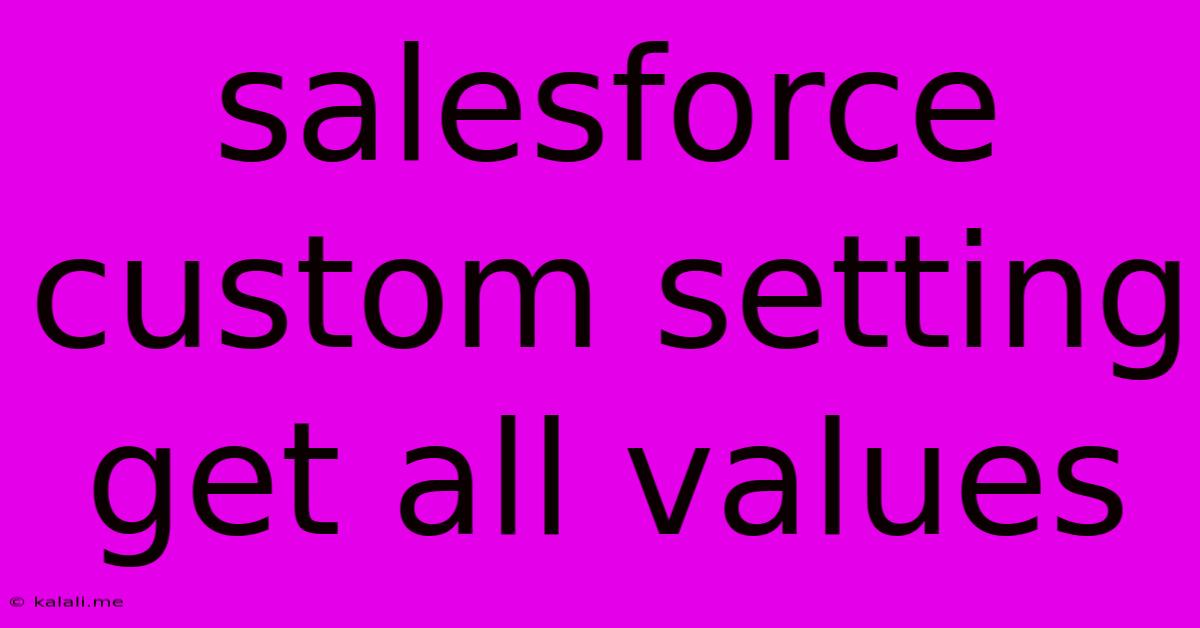Salesforce Custom Setting Get All Values
Kalali
Jun 08, 2025 · 3 min read

Table of Contents
Accessing All Values from a Salesforce Custom Setting: A Comprehensive Guide
Getting all values from a Salesforce custom setting is a common task for developers needing to access configuration data within their Apex code or Lightning Web Components. This guide will walk you through various methods, explaining the differences and best practices for retrieving this information efficiently and effectively. Understanding this process is crucial for building dynamic and configurable applications within the Salesforce ecosystem.
Understanding Salesforce Custom Settings
Before diving into the retrieval process, it's important to understand what Salesforce custom settings are. They are essentially custom metadata types that allow you to store configuration information for your applications. Unlike standard settings, custom settings offer greater flexibility and can be categorized as either list settings (multiple records) or hierarchy settings (hierarchical structure). This tutorial will focus on list settings, as retrieving data from them is the most common scenario.
Method 1: Using getOrgDefaults() for retrieving all values
This is the simplest method, suitable when your custom setting is a list setting and you only need the default organizational values. This method returns a single SObjectType instance representing the default values.
// Assuming your custom setting is named 'MyCustomSetting__c' and has a text field 'MyTextField__c'
MyCustomSetting__c settings = MyCustomSetting__c.getOrgDefaults();
String myTextFieldValue = settings.MyTextField__c;
System.debug('My Text Field Value: ' + myTextFieldValue);
Limitations: This only works for list settings and returns only the default organizational values. If you need to access user-specific values, or if you are working with a hierarchy setting, this method isn't suitable.
Method 2: Querying the Custom Setting using SOQL
For more complex scenarios and greater flexibility, using SOQL to query the custom setting is the recommended approach. This allows you to retrieve all records, filter by specific criteria, and handle different setting types effectively.
// Querying all records from 'MyCustomSetting__c'
List settingsList = [SELECT MyTextField__c FROM MyCustomSetting__c];
for (MyCustomSetting__c setting : settingsList) {
System.debug('My Text Field Value: ' + setting.MyTextField__c);
}
This method offers significant advantages:
- Flexibility: You can easily add
WHEREclauses to filter results based on specific criteria. - Scalability: Efficiently handles large datasets.
- Supports All Types: Works with both list and hierarchy settings.
Method 3: Handling Hierarchy Settings (If Applicable)
If your custom setting is a hierarchy setting, you need to adjust the SOQL query to traverse the hierarchy. The exact approach depends on the structure of your hierarchy setting. Typically, you might use recursive SOQL or a parent-child query to access all values.
Best Practices and Considerations
- Error Handling: Always include error handling (try-catch blocks) to gracefully handle potential exceptions during data retrieval.
- Data Type Considerations: Ensure your Apex code correctly handles the data types of the fields in your custom setting.
- Governor Limits: Be mindful of governor limits, especially when working with large datasets. Consider optimizing your queries and using pagination if necessary.
- Security: Access to custom settings should be appropriately controlled using profile and permission set settings.
By understanding these methods and applying the best practices, you can efficiently retrieve all values from your Salesforce custom settings, enabling you to build robust and configurable applications within the Salesforce platform. Remember to replace "MyCustomSetting__c" and "MyTextField__c" with the actual names of your custom setting and field respectively. This detailed guide provides a complete and comprehensive approach to this common Salesforce development task.
Latest Posts
Latest Posts
-
How Long Does Mixed Neem Oil Stay Good
Jun 08, 2025
-
How To Wire A Three Way Dimmer Switch
Jun 08, 2025
-
How To Heat Up Store Bought French Bread
Jun 08, 2025
-
Can A Catalytic Converter Go Bad
Jun 08, 2025
-
What Is The Difference Between Okay And Ok
Jun 08, 2025
Related Post
Thank you for visiting our website which covers about Salesforce Custom Setting Get All Values . We hope the information provided has been useful to you. Feel free to contact us if you have any questions or need further assistance. See you next time and don't miss to bookmark.